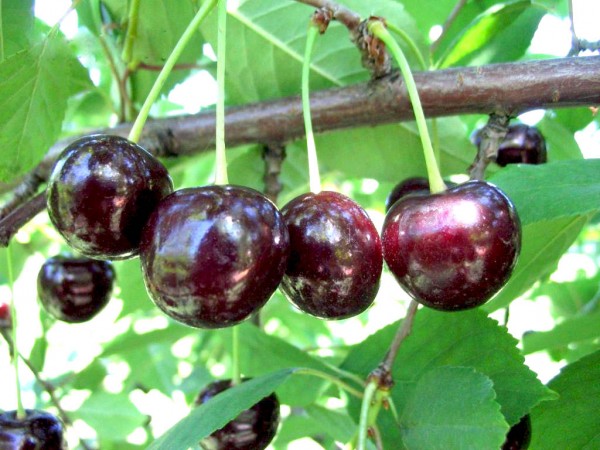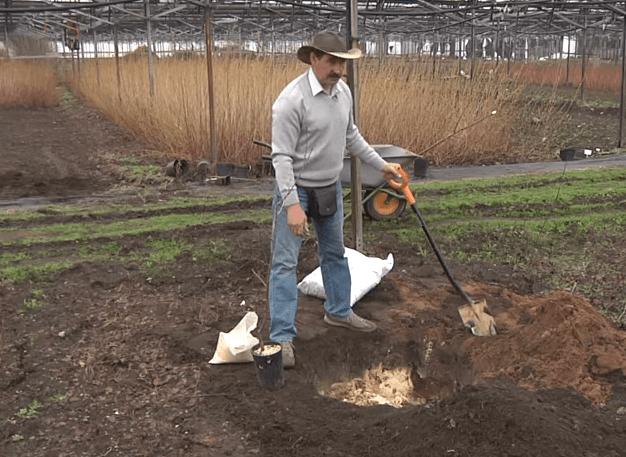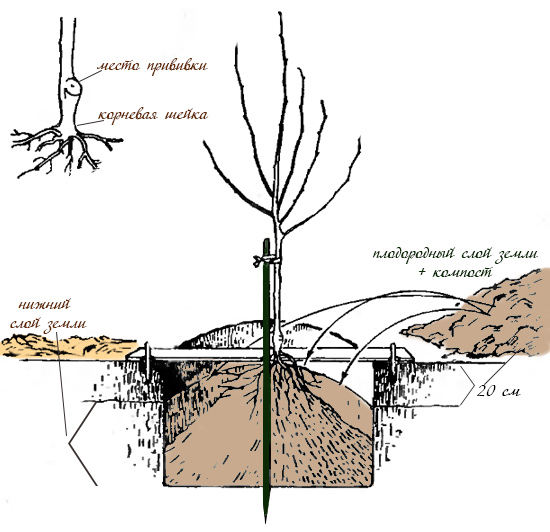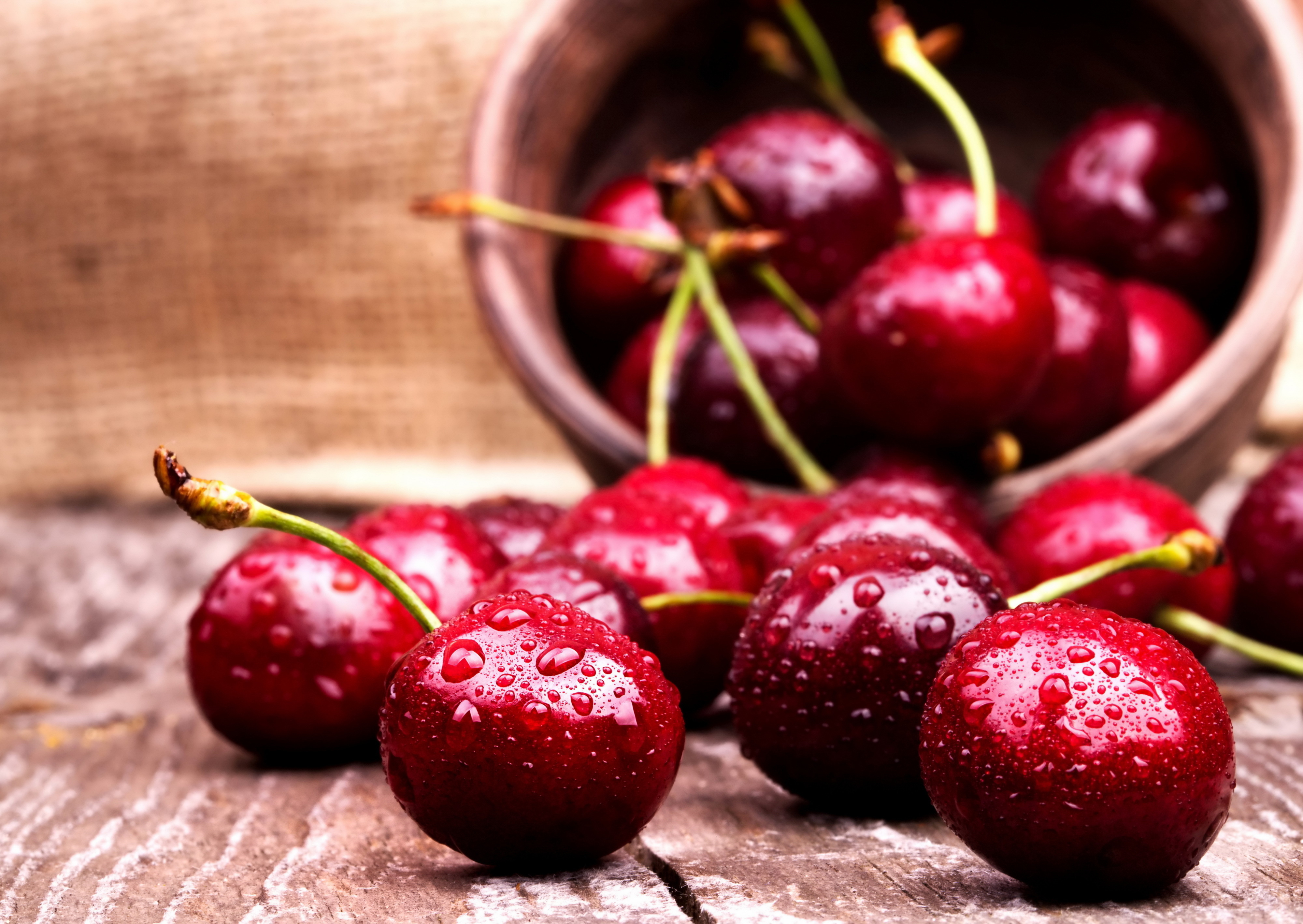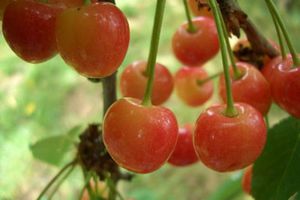Melitopol black is a cherry variety, zoned for the south of Russia. The average yield of a 16-year-old tree is about 80 kg. Fruits are tasty and sweet, they can be picked up and transported by machines.
Content
The origin of the variety Melitopol black
Sweet cherry was bred in the Ukrainian city of Melitopol, where summer lasts more than 120 days: from early May to mid-September. The climate is temperate continental: with dry summers and little snow in winters. The average temperature in winter months is up to -4.5 ° C, in summer - up to +23.5 ° C. It is in such conditions that Melitopol black grows and generously bears fruit.
The first seedlings were obtained at the experimental station of the Institute of Irrigated Horticulture of Ukraine as a result of free pollination of French black. From the first days young seedlings underwent adaptation to the climatic conditions of Melitopol. Melitopol black entered the variety testing in 1958, and in 1974 the variety was included in the State Register of the Russian Federation. Today it is recommended for cultivation in the North Caucasus region.
The State Register of Ukraine includes 3 varieties bred at the Institute of Irrigated Horticulture: Melitopol black (registered 1969), Melitopol early (1976, obtained by crossing the varieties Franz Joseph and Early Mark) and Melitopol red (1996). Sweet cherries differ in appearance and ripening times.
Description of the variety
Melitopol black is a tree with a dense spreading crown, is fast growing and can reach 6 meters in height. Fruiting begins as early as the 4th year after planting. Another important difference is that the variety is resistant to the main enemy of all stone fruit crops - moniliosis. Otherwise, it is a classic southern cherry with very large, beautiful and tasty fruits. Melitopol black berries are well stored and transported. Therefore, in Ukraine, the variety was grown on an industrial scale, the harvest was mechanically harvested and sent in boxes throughout the Union.
In the conditions of Melitopol, the harvest begins to ripen in mid-June. The taste of this cherry is very good, sweet, with a pleasant sourness. The pulp contains more than 13% sugar. The fruits are large, with an average weight of 6–8 g, but there are specimens of 11–12 g each. Separation from the stalk is dry, the skin is thin but dense. Ripe berries hang on the branches for up to a month, do not crumble or rot. The stone is not large, it is easily separated. The pulp is dense, dark red, the juice is rich, burgundy.
Cherries also have disadvantages: they are self-fertile and, of course, the southerner does not tolerate low temperatures well. In winter, at -25 ° C, 40% of the flower buds freeze out. With spring return frosts, more than 50% of pistils die during flowering. But this disadvantage is not so important if you grow Melitopol black in the areas for which it is intended.
Video: the harvest of Melitopol black is ripe
Planting cherries
Seedlings with a closed root system can be transplanted by transshipment all year round, and with an open one - only during the dormant period: before bud break in spring or autumn after leaf fall. Choose a sunny location for cherries, preferably in the southern part of the garden, sheltered from the wind. Rain and melt waters should not stagnate on the site.
For cross-pollination, other cherries or cherries are needed. They can grow both on yours and on neighboring plots at a distance of up to 50-60 m. The main thing is that the pollinating trees bloom in the same period as Melitopol black.
The best pollinators for Melitopol black: Dybera black, Large-fruited, Kurortnaya, Cosmic, Surprise.
To plant, step back 4.5–5 meters from the nearest buildings, fence, and other trees. Cherry loves light sandy loam or loamy soil, permeable and fertile. Clay, peat and sandy need to be improved by digging a planting hole in advance and filling it:
- compost or humus (1: 1 with soil);
- fertilizers: 350 g of nitroammofoska for spring planting or 50 g of potassium sulfate and 100 g of superphosphate - for autumn;
- 400 ml dolomite flour if the soil is acidic.
Dig a hole 80 cm in diameter and 60 cm deep. To make up the soil mixture, take the soil of the upper layer, the soil from the lower 30 cm is unsuitable for planting, it must be removed from the site.
Stages of planting cherries:
- Place a seedling with an open root system in water for at least 2 hours, maximum for a day.
- Cut the stem to a height of 60 cm. The cut should be green. If it is dry (brown), trim to healthy. It is important that at least a stump with 3-4 buds remains above the inoculation.
- Install a peg in a pre-prepared planting hole and make a hole on the south side to the size of the roots.
- Spread the roots so that there are no twists and bends. Place the seedling so that the root collar is at the level of the soil, and the graft is a few centimeters higher.
- Sprinkle the roots with fertilized soil, tamp lightly, make an irrigation hole with sides.
- Water with 1–2 buckets of water, mulch with hay, cut grass, or simply sprinkle with dry, loose soil.
Formation of cherries like a Spanish bush
Since Soviet times, the formation of sweet cherries has been practiced as a sparse tiered crown - this is a tree in one trunk 5-7 meters high. Fruiting begins late, and over the years goes to the top and periphery of the crown. In modern gardens, they have already learned to restrain the exuberant growth of unnecessary wood and green mass and direct their forces to the formation of the crop. Now the formation of the type of the Spanish bush is very popular. As a result, cherries grow up to 2.5–3 m in height, you can pick berries without stairs, and it is also easier to hide such a plant from birds. The scheme is suitable for any variety: both dwarf and tall.
The Spanish Bush method sounds like Spanish Bush in English. Such a formation is widely used in Spain, but is not suitable, for example, for Poland with its changeable weather. On bush cherries, flower buds form low above the ground and suffer greatly during recurrent frosts, while in the upper part of the crown of the tree they would remain intact.
Melitopol black, both in the place of growth (south of Russia), and in the shape of the crown, seems to have been created for such a formation. The fact is that in other cherries in the first year, the main branches have to be bent up to 60 ° relative to the trunk with the help of weights or pegs. And the botanical features of Melitopol black will free you from this agricultural practice. The angle of departure of its skeletal branches from the trunk is 54–62 °.
Video: pruning like a Spanish bush
Cherry pruning scheme:
- First year.
- In spring, cut the seedling at a height of 30 cm, maximum 70 cm if the lower buds are dead.
- Side shoots will begin to grow in summer.Leave four, located at the top and directed in different directions, and pluck the rest green.
- When the skeletal shoots left behind grow to a length of 50 cm, cut them at the same level, as if using a ruler. In this case, the upper shoots will be shorter than the lower ones (about 25–30 cm), but the tops of all four should be at the same level and form a straight line. It is impossible to be late with shortening, during the season the shoots of the second order must have time to grow and ripen.
- As a result of such pruning, tops (vertical shoots) will begin to actively grow, they must be constantly cut out.
- Second year. The Melitopol black bush will consist of a short stem, four skeletal branches with 3-4 long shoots of the second order on each. Now we have to form the bowl.
- In the spring, when the branches become flexible, but always before budding, place the lowest second-order shoots on each skeletal branch horizontally and fix it with pegs. As a result, the main shoots will also tilt and unfold.
- During flowering, shorten all other twigs of the second order to 30 cm, cutting again at the same level, as in a ruler.
- In the middle of summer, when third-order growths appear and reach a length of 50 cm, the procedure with pulling the lowest ones to the horizontal position and cutting the rest to a height of 30 cm from the base is repeated, but with third-order shoots.
- Third and all subsequent years. The Spanish bush is formed.
- Carry out thinning; shorten all shoots beyond the size of the crown (2.5 m in height); cut branches growing inward and vertically upward.
- Rejuvenate the bush. When the main skeletal branches are exposed, start cutting one at a time. In this case, leave a section (stump) 30 cm long from the trunk. Several shoots will grow from the remaining buds, choose the most powerful and correctly located for replacement.
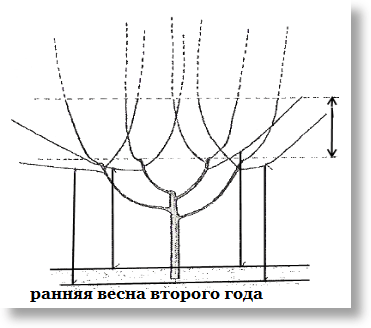
The Spanish bush is formed in the form of a bowl: the shoots of each tier are cut along one line, the lowest lateral growths are bent to a horizontal position
Always prune shoots above the outward bud, not inward.
Watering and feeding cherries
A young seedling does not need top dressing before entering fruiting, it is enough what is introduced into the planting pit. But you need to water the young tree regularly, with such frequency that the soil is always moist. The watering rate is 2-3 buckets for each square meter of the trunk circle, which will grow in proportion to the crown with the age of the tree. From the year of entry into fruiting, start fertilizing.
Combine top dressing with watering. These two agricultural practices can increase yields. Drizzle over the cherries:
- during the budding period;
- during the growth of the ovaries, when they grow to the size of a pea;
- in the fall, before frost.
If the weather is hot and dry for more than a week, then arrange additional watering. Water mature trees in a groove up to 20 cm deep, which must be done around the circumference of the crown.
Video: watering cherries in the groove
Combine the first and last watering with top dressing. Sprinkle 200-300 g of urea along the groove in the spring, and 400 g of superphosphate and 200 g of potassium salt in the fall. Before the onset of cold weather, cover the trunk circle with a layer of humus or compost (5–10 cm). Cherry roots will receive protection from the cold and nutrition, which they will begin to assimilate in the spring. In addition, once every 5 years, you need to deoxidize the soil by adding fluff lime or dolomite flour. The rates depend on the acidity of the soil and are written on the package.
Indicators for determining the acidity of the soil can be bought in pharmacies, pet stores, chemical reagents departments, etc. solution. Compare the color with the indicator bar, which should be in the kit.
About diseases and pests of Melitopol black
Melitopol black does not suffer from moniliosis, she is not afraid of gray rot. The fruit is more likely to dry out on the branches and turn into dried fruit than rot. All fungal diseases develop in conditions of high humidity, and the south of Russia is famous for its warm and dry summers. Therefore, it is not surprising that diseases are not mentioned about the variety in gardeners' reviews. But many people complain about birds that spoil up to 40% of the harvest and more.
There are two effective ways to protect against feathered pests:
- Mesh or covering material. Cherries need to be wrapped whole, clever birds can fly in from below and into any crevice.
- Mulberry. Plant this tree on a plot or behind a fence. Birds will not be interested in cherries until they eat the mulberries.
There are testers who have verified the effectiveness of the ultrasonic mouse repeller. Also, bioacoustic devices of the Korshun, Sapsan and other brands are actively advertised. Shiny discs, scarecrows, Christmas tree decorations, spinning plastic bottles have already proved their uselessness. Our feathered friends quickly recognize inanimate objects and stop responding to them.
Harvesting and processing
The purpose of this cherry is universal. It is grown both for the market and for oneself, they eat fresh berries and make preparations. Melitopol black can be frozen, after thawing it retains its shape and does not flow. If the fruits are to be transported and stored, then pluck them together with the stalks in the morning, when the dew has already dried, but the berries have not yet been warmed up by the sun. In the refrigerator, cherries are kept fresh for up to two weeks.
Melitopol black is so fruitful that you will have enough berries for many different preparations. They will make excellent dried fruits, fillings and decorations for baking, preserves and compotes, jams and marmalades, candied fruits and sweets. The juice from this cherry is very beautiful and aromatic, and if it ferments, you will get an excellent raw material for fruit wine or brandy.
Video: pickled cherries for meat and salads
Reviews of Melitopol black
Melitopol black is growing at the parents. The tree is high, 6 meters, to tear the top off is unrealistic. So the most ripe and beautiful berries are pecked by birds. The tree is not trimmed or processed by anything. The berries are very tasty, black and large.
I do not remember how many years ago I was presented with the Melitopol black variety, this year the fruits have already started, I can't wait to try it, they said that it was insanely tasty.
Sweet cherry, the best, Melitopol. Also huge sweet and sour. It was sent by air up to Vorkuta. Everything else is bullshit, it is impossible to compare.
Melitopol black - sweet cherry with one drawback. The tree grows very quickly and forms a huge crown. Therefore, the difficulty in growing this fruitful beauty is also only one - correct pruning, which will restrain the growth of unnecessary shoots and send all the juices to the laying of the crop.
